As Parliament seeks to cut debt supply, the Executive is opting for “hidden” loans to put up flashy projects, with a Sh65 billion flying highway to be built by a Chinese firm that will not pay taxes for years.
Analysts have condemned the project, saying it will need heavy subsidies, including value added tax, withholding tax and corporate tax during construction, and decades of operation that will run into billions, money that should go into building schools and hospitals.
The double-decker highway will serve a small elite that does not want to be inconvenienced by traffic when they to fly in and out of the country.
“I don’t think we should be doing this. We are not collecting enough taxes to pay salaries, so the last thing we should be doing is giving away some of it,” Mr Robert Shaw, a local economist, said.
Flashy Projects
He added that there is need to reconsider this love for flashy projects, whether we can afford them, and if not, consider cheaper alternatives. Architect and urban planner Alfred Omenya of Eco Build Africa was more brutal in his assessment of the project: “The Airport-James Gichuru expressway isn’t feasible, whichever way one looks at it.
He questions the rationale for investing in a grandiose project that will serve a few people.
“CRBC claims that it will cost Sh3.2 billion per km to construct. To put this in perspective, Thika Road cost us about Sh620 million per kilometre. This project, though more majestic, would cost us 600 per cent more. Anyway, who has come up with these costs? It is CRBC.
These are the costs it must recover and make profits before handing us the expressway in 2049 … By 2050, CRBC projects that the daily passenger numbers from JKIA will be 54,000. By then the day population needing to move in Nairobi will be 14 million.
The expressway will be serving a mere 0.38% of the Nairobi population. Ninety-nine per cent will be salivating as the 0.38% eat their “nyama”. Is that equitable use of public resources?”
Civil Works
The project was initially conceptualised in 2008 and was to be funded by the World Bank as part of a programme to improve transport along selected roads in Nairobi, Kisumu and Meru counties before it was dropped.
“The activities that have been dropped include civil works on the section from the JKIA turn-off to the Southern Bypass; the Southern Bypass to the James Gichuru Road junction, and promotion of private sector participation in the road subsector,” the World Bank said last year.
The expressway has drawn mixed reactions after it emerged that it will cut through the iconic Uhuru Park, the University of Nairobi grounds and other key structures in the city.

The government will shoulder the burden of compensating private property owners along the project including Nextgen Mall, Khalsa School, University of Nairobi, St Paul’s Chapel and Hotel Boulevard, which will run into billions of shillings, further raising the cost of the project.
However, some analysts say easing congestion will ensure that Kenya remains the regional hub and consolidate the United Nations complex, which the road primarily serves.
Besides not being a priority project of the Jubilee government, which has run out of borrowing options, it will load the cost on taxpayers through tolling.
Private Basis
Funding was secured last year during the Forum on China-Africa Cooperation (FOCAC) in Beijing which, incidentally, turned down funding for the completion of the Standard Gauge Railway, which is stuck in Suswa.
“We have engaged financial partners but until now, nothing much has happened. This time we have a commitment from a private investor here in China, who will do that road on a private basis. They do the road, they recover the money then, after some time, the road comes back to us,” Transport CS James Macharia said at the time.
As Kenya heads for a debt crisis, taxpayers will have to question whether the flashy spending has realised value for money, or whether the government has sunk money into white elephants that continue to bleed the economy rather than offer any return.
ABSA GROUP
“It is not a Kenyan problem, a lot of African countries will be asking whether the projects have a return. I believe some of them will, but some will not,” said Mr Jeff Gable, head of research at Absa Group.
While launching the second phase of the Standard Gauge Railway, President Uhuru Kenyatta dismissed critics as myopic, saying the project was meant for future generations.
“We are looking at 20 and 50 years to come and these areas now being referred to as nowhere will be like Nairobi. That is what our focus is on,” he told the residents of Maai Mahiu.
The 120-kilometre railway line, however, terminates in a remote village off Duka Moja on the way to Narok. No station exists on the final 20-km stretch, and it will operate only twice a week.
Kenya has also spent Sh3 billion reviving the Kisumu port to ferry fuel to Uganda, barely two years after building a Sh1.9 billion jetty for the same purpose. The jetty has been lying idle since February, 2017.
It is these projects funded by loans that have breached Kenya’s borrowing ceiling, making it difficult to secure funding to complete the SGR to Kisumu.
Ballooning Debt
The United States has repeatedly warned the country against the ballooning debt.
“Kenya has hit a debt ceiling … the onus is on Kenya to put its debt in order,” US Ambassador Kyle McCarter has said. “We don’t want to put debt on Kenyans. We want to do business in a transparent and ethical way,” he told the Nation last week.
Kenya’s public debt currently stands at around $60 billion (Sh6 trillion), or 63 per cent of the GDP, and while such warnings might sound foreign-based, local alarm bells have been ringing, but no one has paid attention.
The Parliamentary Budget Office (PBO) last week warned Kenya had breached the East Africa Community ceiling on debt accumulation after lawmakers voted to increase the debt ceiling to Sh9 trillion ($90 billion) in the 2019/2020 fiscal year.
Single Currency
The region’s target is that debt should not exceed 50 per cent of a country’s GDP, and the PBO was concerned that Kenya’s growing debt-to-GDP ratio had placed the country in a difficult position to comply with the regional agreement on attaining a single currency.
“The country will no longer comply with the EAC convergence criteria, which it is a signatory to,” the PBO said in its submissions to the Parliamentary Committee on Delegated Legislation in Nairobi.
The raised ceiling will also increase debt repayment figures and undermine the credibility of the national budget, that was all set to reduce the debt-to-GDP ratio to 50.6% in the 2019/2020 fiscal year.



